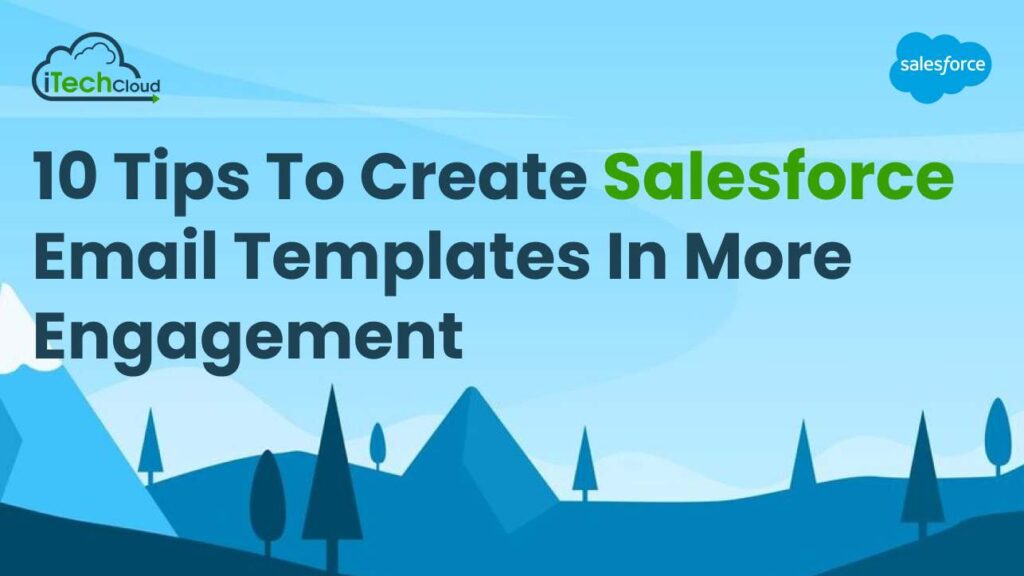10 Tips to Create Salesforce Email Templates in more engagement

Understanding Salesforce Email Templates:
Salesforce email templates are pre-designed messages crafted within the Salesforce platform for efficient communication with customers. These templates streamline outreach by providing customizable content for various purposes, such as marketing campaigns, customer support, or sales follow-ups. They include dynamic fields to personalize messages with recipient-specific details, enhancing engagement and relevance. Users can create, edit, and store templates in Salesforce’s repository, ensuring consistency and professionalism across communications. With features like merge fields and HTML customization, these templates empower users to deliver compelling emails efficiently, ultimately improving communication effectiveness and customer relationships within the Salesforce ecosystem.
Table of Contents
We’ll explore ten expert tips to help you optimize your Salesforce Classic Email Templates for maximum effectiveness, from setting clear objectives to complying with regulations.
1. Define Your Objectives:
How to use email templates in Salesforce creation process, it’s crucial to establish clear objectives for your email campaigns. Determine whether you’re aiming to nurture leads, promote products, or provide customer support. Defining your goals upfront will guide the content and design of your templates, ensuring they align with your overarching strategy.
2. Know Your Audience:
Understanding your audience is fundamental to crafting engaging and relevant email content. Segment your email list based on demographics, interests, and past interactions with your brand. This allows you to tailor your messaging to resonate with different audience segments, increasing the likelihood of engagement and conversion.
3. Use Consistent Branding:
Maintaining consistency in branding across all your communications is essential for building brand recognition and trust. Incorporate your company’s logo, colors, and fonts into your Salesforce Email Template Builder to reinforce your brand identity. Consistent branding helps to create a cohesive experience for recipients and enhances the professionalism of your emails.
4. Keep it Simple and Clear:
In today’s fast-paced digital world, simplicity is key to capturing and retaining the attention of your audience. How to create Email Template in Salesforce Lightning concise and focused, using clear language and formatting to convey your message effectively. Break up the content with bullet points, headers, and white space to improve readability.
5. Focus on Value:
Every email you send should provide value to the recipient in some way. Whether it’s informative content, exclusive offers, or helpful resources, ensure that your emails offer something of value that resonates with your audience. Consistently delivering value builds trust and credibility with your subscribers, driving engagement and loyalty.
6. Personalize Where Possible:
Personalization is a powerful tool for increasing email engagement and conversion rates. Utilize Salesforce’s merge fields to personalize your Salesforce email templates merge fields with recipient names, company details, or past interactions. Personalized emails demonstrate that you understand and value your recipients, making them more likely to open and engage with your messages.
7. Include Clear Call-to-Actions (CTAs):
Every email should include a clear and compelling call-to-action (CTA) that prompts the recipient to take the desired action. Whether it’s signing up for a webinar, downloading a resource, or making a purchase, your CTAs should be prominently displayed and easy to follow. Use actionable language and eye-catching design elements to encourage click-through.
8. Optimize for Mobile Devices:
With the increasing prevalence of mobile devices, it’s essential to ensure that your Salesforce Lightning email templates are optimized for mobile viewing. Use responsive design techniques to ensure that your emails render correctly and are easy to read on smartphones and tablets. Test your templates across different devices and screen sizes to ensure a seamless experience for all recipients.
9. Test and Iterate:
Continuous testing and optimization are key to improving the effectiveness of your salesforce email template over time. Conduct A/B tests to compare different subject lines, content variations, or design elements and identify what resonates best with your audience. Analyze metrics such as open rates, click-through rates, and conversions to inform your optimization efforts and refine your templates accordingly.
10. Comply with Regulations:
Ensure that your email templates comply with relevant regulations such as GDPR or CAN-SPAM to maintain trust with your audience and avoid legal issues. Include a clear unsubscribe link and honor opt-out requests promptly to demonstrate respect for recipients’ privacy preferences. Staying compliant with regulations not only protects your brand reputation but also fosters a positive relationship with your audience.
Conclusion:
Optimizing Salesforce email templates for increased engagement requires a strategic approach focused on audience understanding, clear objectives, and compelling content. By defining clear objectives and knowing your audience, you can tailor your email templates to resonate with recipients’ interests and needs. Consistent branding and clear, concise messaging further enhance engagement, while personalization and value-driven content create a more personalized experience.
Including clear call-to-actions and optimizing for mobile devices ensure that recipients can easily interact with your emails. Additionally, continuous testing and compliance with regulations are essential for refining and maintaining email template effectiveness. By implementing these tips, you can create Salesforce email templates that captivate recipients, drive interaction, and ultimately, foster stronger connections with your audience.

